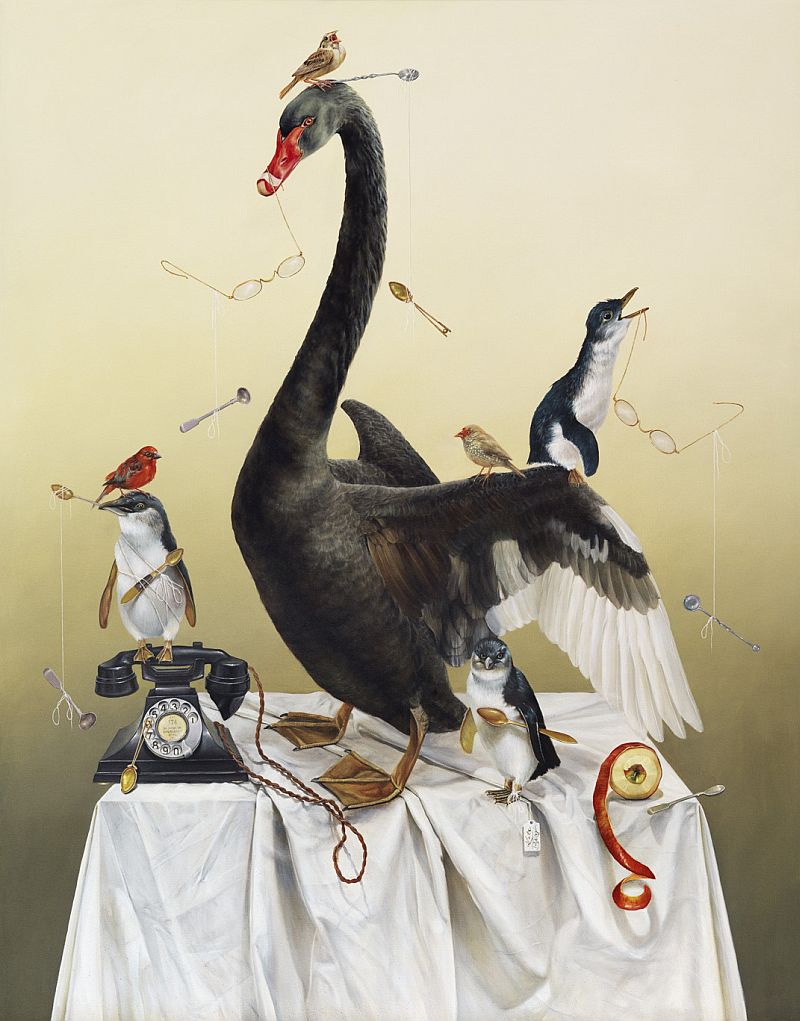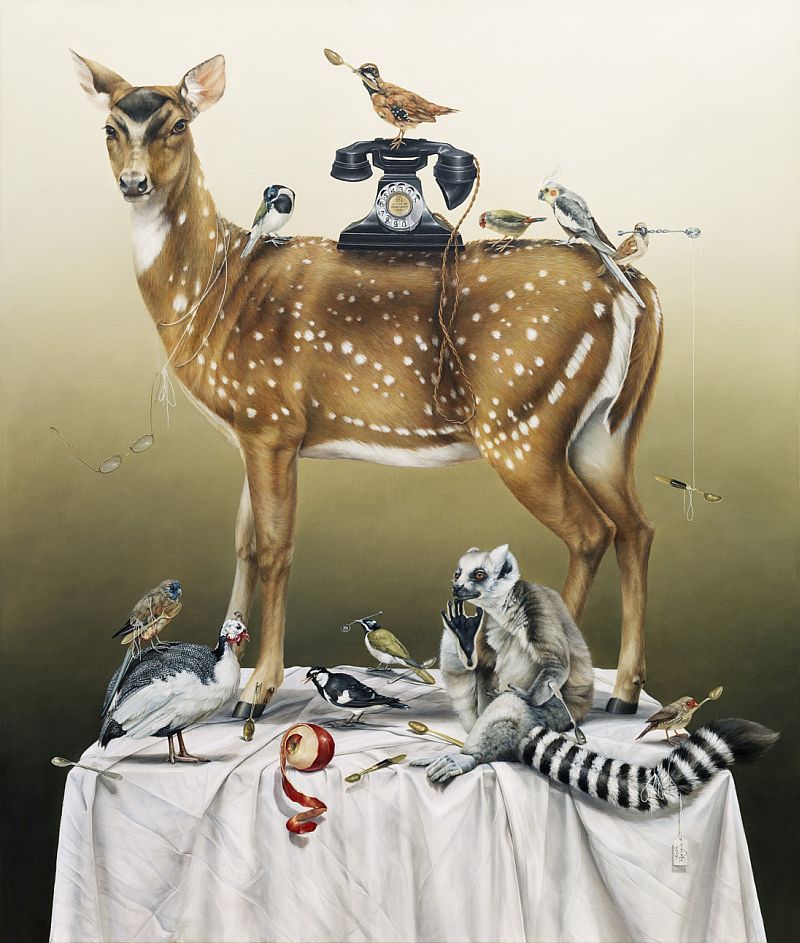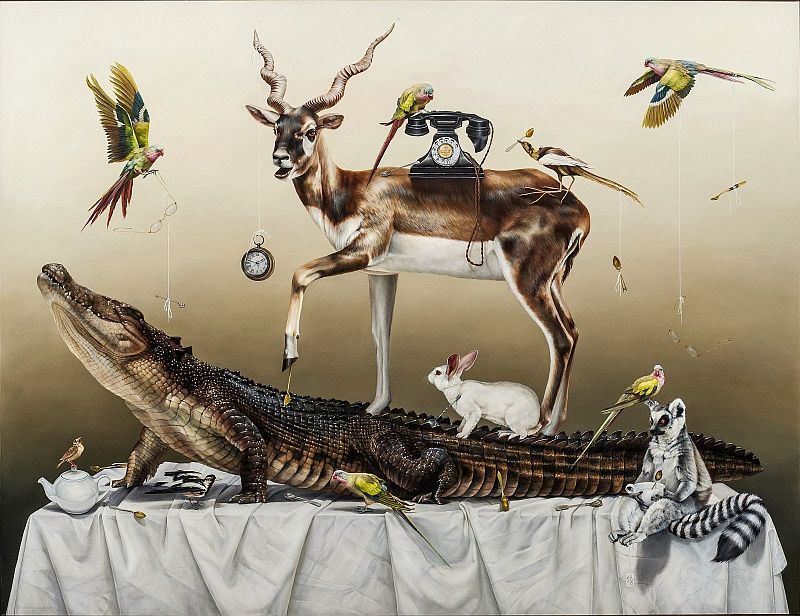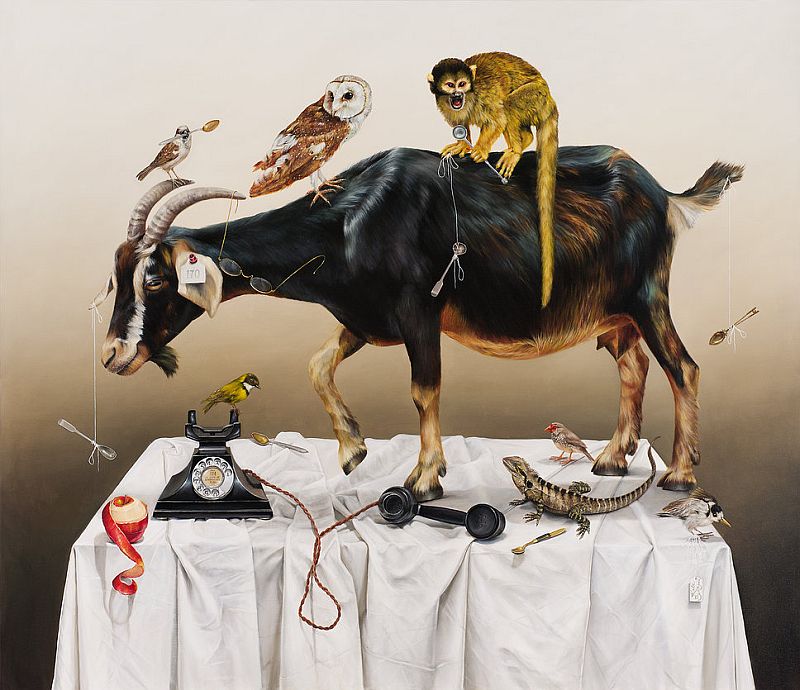Kate Bergin
Kate Bergin, con su obra "Sobre sus alas clamorosas" / with her work "Upon Their Clamorous Wings", 2013
Kate Bergin es una artista australiana nacida en 1968 en Melbourne.
Estudió en el Victorian College of the Arts entre 1990 y 92, mientras el edificio principal estuvo ubicado en St Kilda Road, el Departamento de Pintura estaba alojado en la parte posterior de la Galería Nacional de Victoria.
«La posibilidad de acceder a la colección a diario y estudiarla de cerca tuvo una enorme influencia sobre mí y me hizo apreciar la gran técnica de pintura.
Uno de mis artistas favoritos era Hugh Ramsay (ver más abajo), un australiano considerado uno de los grandes estudiantes de la escuela de la galería. Fue reconocido en el Salón de París de 1902 pero murió a la edad de 29 años en 1906. Encontré algunos hermosos dibujos suyos en los almacenes la Escuela de la Galería.»
"Sobre sus alas clamorosas / Upon Their Clamorous Wings"
Óleo sobre lienzo / oil on canvas, 170 x 200 cm., 2013
"La habitación veneciana / The Venetian Room", óleo sobre lienzo / oil on canvas, 170 x 200 cm., 2016
(la pintura detrás es de / painting in the back by Canaletto - ver más abajo / see below)
"Black Swan or Trespass Some Angry Penguins"
Óleo sobre lienzo / oil on canvas, 143 x 112 cm., 2011
«Desde mi graduación he estado explorando el género de la naturaleza muerta y la idea de la caza y la recolección.
Desde mis pinturas iniciales de cientos de manzanas rojas deliciosas a colecciones de polillas y mariposas que reuní durante mi estancia de cinco años en Cairns, y mi descubrimiento de Ellis Rowan (ver más abajo) y sus aventuras y hermosas obras de arte, me he paseado por las colecciones de aves y animales, principalmente de los almacenes del Museo Victoria y también de animales vivos en zoológicos de todo el país. También estoy recolectando mi propia colección de especímenes de aves y animales, particularmente mis muy pintados zorros.
Estas criaturas son mis "colaboradores inteligentes, símbolos del pensamiento y de la imaginación" como Kynaston McShine dice del uso constante de pájaros de Joseph Cornell en sus ilustraciones.»
"Performances sobre la mesa y otras historias no contadas /
Tabletop Performances & Other Untold Stories"
Óleo sobre lienzo / oil on canvas, 170 x 200 cm., 2013
"Reunión de té de las alpacas / The Alpacas' Teaparty"
Óleo sobre lienzo / oil on canvas, 168 x 228 cm., 2011
"Amigos imaginarios / Imaginary Friends", óleo sobre lienzo / oil on canvas, 112 x 142 cm., 2015
«Todos estos objetos y criaturas están presentados sobre un mantel blanco, como una especie de ofrenda en un altar para el espectador. Este despliegue también representa la conexión con la tradición de la naturaleza muerta de la cual yo soy parte, sobre todo después de leer el libro de Norman Bryson"Looking at the Overlooked (Mirando lo pasado por alto)", que explora el camino del género de la naturaleza muerta.
La continua presencia de las cucharas, las gafas, los teléfonos, las armas y las llaves con las cuales las criaturas parecen "sacar una chispa de su contacto" como Andre Breton sugirió en sus primeros escritos, recordándonos que la vida puede ser absurda, hermosa y a veces como un cuento de hadas, sólo un poquito aterradora.»
"Trapecista / The Trapeze Artist", óleo sobre lienzo / oil on canvas, 150 x 80 cm., 2013
«Aunque sitúo a los animales en un entorno doméstico y pueden sostener objetos, intento mantener esto dentro de los límites de lo que realmente podrían hacer como animales. Esto preserva la sensación de que sólo están visitando y explorando este extraño mundo. Necesitan mantener su propia sensación de cosa silvestre. Espero que las pinturas existan en el límite de lo posible, en lugar de volcarse hacia el surrealismo o la pura imaginación.»
"Descanso / Intermission", óleo sobre lienzo / oil on canvas, 170 x 200 cm., 2016
(la pintura detrás es de / painting in the back by Frans Snyders - ver más abajo / see below)
Hay una exquisita atención al detalle en las pinturas de Kate, que no sólo se refleja en la meticulosa representación de los objetos y animales, sino también en la selección de elementos, su disposición dentro de la obra y lo que representan. Según ella misma acerca de la manzana que aparece junto al teléfono:
«La clásica fruta pelada hace referencia al género del bodegón español del s.XVII, y al situarla sobre una pequeña taza de café de Tiffany & Co, que lleva las notas de "Moon River", de Henry Mancini, uno no puede menos que oir a Audrey Hepburn candanto la letra de Johnny Mercier incluida en la línea: "There's such a lot of world to see (Hay tanto mundo para ver)", lo que se refleja en la pintura que aparece detrás del guepardo, una recreación de "Concierto de aves" de Frans Snyder (ver más abajo), que recientemente se expluso en la Galería Nacional de Victoria, procedente de la colección del Museo Hermitage. Así que hay una variedad de referencias a través de los siglos y países en esta pintura... definitivamente, mucho mundo para ver aquí.»
There's an exquisite attention to detail in Kate's paintings, which is reflected not only in the meticulous depiction of objects and animals, but also in the selection of elements, their arrangement within the work and what they represent. According to herself, talking about the apple that appears next to the phone:
«The classic peeled fruit references the still life genre from the Spanish 17th century and by placing it on a little espresso cup from Tiffany & Co which has the notes from Henry Mancini's "Moon River" you can't help but hear Audrey Hepburn singing the Johnny Mercer lyrics including the line, "There's such a lot of world to see" which reflects back to the painting behind the cheetah which is a recreation of Frans Snyders (see below), Concert of Birds which recently toured to the National Gallery of Victoria from the Hermitage Collection. So there's a variety of references across centuries and countries in this painting... definately a lot of the world to see here.»
_____________________________________________
"Feria de las vanidades / Vanity Fair", óleo sobre lienzo / oil on canvas, 170 x 200 cm., 2012
Kate Bergin, con su obra "Aquí es donde nos encontramos" / with her work "Here is Where We Meet"
Kate Bergin is an Australian artist born in 1968 in Melbourne.
She studied at the Victorian College of the Arts from 1990-92, while the main building was located on St Kilda Road the Painting Department was housed at the back of the National Gallery of Victoria.
«Being able to access the collection on a daily basis and study it up close had an enormous influence on me and gave me an appreciation for great painting technique.
A favourite artist of mine was Hugh Ramsay (see below), an Australian artist considered one of the great students of the Gallery School. He was celebrated at the Paris Salon of 1902 but died at the age of 29 in 1906. I found some beautiful sketches of his in the storerooms from his time at the Gallery School.»
"Aquí es donde nos encontramos / Here is Where We Meet"
Óleo sobre lienzo / oil on canvas, 165 x 140 cm., 2013
"Contra la ociosidad y la travesura / Against Idleness and Mischief"
Óleo sobre lienzo / oil on canvas, 180 x 235 cm., 2013
"Canciones de inocencia y experiencia: Un tigre para Mr. Blake /
Songs of Innocence and Experience: A Tyger for Mr. Blake"
Óleo sobre lienzo / oil on canvas, 170 x 220 cm., 2012
«Since graduating I have been exploring the still life genre and the idea of hunting and collecting.
From my initial paintings of hundreds of red delicious apples to collections of moths and butterflies which I gathered during my five year stay in Cairns, and my discovery of Ellis Rowan (see below) and her adventures and beautiful artworks, I have moved on to collections of birds and animals mainly taken from the storerooms of Museum Victoria and also from live animals in zoos around the country. I am also gathering my own collection of bird and animal specimens particularly my much painted foxes.
These creatures are my “intelligent collaborators, symbols of thought and imagination” as Kynaston McShine says of Joseph Cornell’s constant use of birds in his artwork.»
"El fantástico Sr. Zorro / The Fantastic Mr Fox"
Óleo sobre lienzo / oil on canvas, 76 x 101 cm., 2010
"El arte de la espera / The Art of Waiting", óleo sobre lienzo / oil on canvas, 120 x 185 cm., 2014
"Fábulas para cebras y otras historias / Cautionary Tales for Zebras & Other Stories"
Óleo sobre lienzo / oil on canvas, 170 x 200 cm., 2016
«All these objects and creatures are presented on the white cloth as a kind of altar-like offering to the viewer. This display also represents the connection with the tradition of still life which I am very much a part of, particularly after reading Norman Bryson's Looking at the Overlooked which tracks the journey of the still life genre.
The continuing presence of the spoons, spectacles, telephones, guns and keys with which the creatures seem to be “drawing a spark from their contact” as Andre Breton suggested in his earliest writings, reminding us that life can be absurd, beautiful and sometimes like any fairy-tale, just a little bit frightening.»
"Practicando el arte del engaño y otras ilusiones / Practicing the Art of Deception & Other Illusions"
Óleo sobre lienzo / oil on canvas, 203 x 235 cm., 2014
(la pintura detrás es de / painting in the back by Claude-Joseph Vernet - ver más abajo / see below)
"Modales en la mesa / Table Manners", óleo sobre lienzo / oil on canvas, 170 x 220 cm., 2016
"Balada sobre la mesa / Tabletop Ballad"
Óleo sobre lienzo / oil on canvas, 170 x 250 cm., 2016
«Though I place the animals in a domestic setting and while they may hold objects, I try to keep this within the bounds of what they might actually do as animals. This retains the sense that they are just visiting and exploring this strange world. They need to retain their own sense of wildness. I hope the paintings exist on the edge of the possible rather than tipping over into surrealism or the purely imagination.»
"La sociedad de autoconservación / The Self Preservation Society"
Óleo sobre lienzo / oil on canvas, 112 x 142 cm., 2012
__________________________________________
Fuentes / Sources:
* Website
* Artículo de / Article by Carolyn McDowall, Thecultureconcept Circle, 8/2012
* Entrevista de / Interview by Prue Gibson,
Art Collector 2015 Special Edition (Sydney Contemporary), pp. 18-19. Link
Fuentes / Sources:
* Website
* Artículo de / Article by Carolyn McDowall, Thecultureconcept Circle, 8/2012
* Entrevista de / Interview by Prue Gibson,
Art Collector 2015 Special Edition (Sydney Contemporary), pp. 18-19. Link
Más sobre Kate Bergin en / More about Kate Bergin in:
Imágenes publicadas con autorización de la artista (¡Muchas gracias, Kate!)
Images published here with artist's permission (Thanks a lot, Kate!)
Images published here with artist's permission (Thanks a lot, Kate!)


Algunas referencias / Some References
Hugh Ramsay
"Autorretrato con chaqueta blanca / Self-portrait in White Jacket"
Óleo sobre lienzo / oil on canvas, 92,3 x 73,5 cm., 1901-02
National Gallery of Victoria (Melbourne, Australia). Google Art Project
Hugh Ramsay fue un artista australiano nacido en 1877 en Glasgow, Escocia. Se mudó con su familia a Melbourne en 1878.
Fue educado en Essendon Grammar School, y tomó clases en la Galería Nacional de Victoria a los 16 años bajo la dirección de Lindsay Bernard Hall, convirtiéndose en uno de los estudiantes más brillantes instruido allí. Ganó varios primeros premios, y en la competición por la beca de viajes que allí se ofrecía en 1899, fue vencido estrechamente por Max Meldrum, otro estudiante de inusual capacidad.
Ramsay viajó a Europa en septiembre de 1900. Al llegar a París, entró en la Academia Colarossi y pronto fue reconocido como un estudiante de gran potencial. Envió cinco cuadros a la exposición de 1902 de la Société Nationale des Beaux-Arts y cuatro de ellos fueron aceptados y colgados. No se podía haber hecho mayor cumplido a un joven estudiante. Otro estudiante australiano tenía su estudio en el mismo edificio, Ambrose McCarthy Patterson (cuñado de Nellie Melba, por aquél entonces en la cima de su fama). Ramsay fue presentado a Melba, que le encargó un retrato y sin duda podría haberle ayudado en su carrera. Lamentablemente Ramsay enfermó en París, y debió regresar al clima más cálido de Australia, con lo que la oportunidad de pintar para Melba se perdió. Antes de salir de Europa, había expuesto cuatro cuadros en la British Colonial Art Exhibition celebrada en Londres en las galerías del Real Instituto.
A su regreso a Australia, a pesar de la salud deficiente, Ramsay logró hacer un trabajo notable, con obras como Las Hermanas, Dama con abanico (posiblemente su pintura más famosa), el retrato de David Scott Mitchell, y el suyo propio, hoy en la Galería Nacional de Victoria, en Melbourne. Poco a poco se debilitó y murió en Clydebank cerca de los lagos Gippsland el 5 de marzo de 1906 unas semanas antes de alcanzar los 29 años.
"Las hermanas / The Sisters", óleo sobre lienzo, sobre panel / oil on canvas on hardboard, 156 x 176,5 cm., 1904
Art Gallery of New South Wales (Sydney, Australia). Google Art Project
Hugh Ramsay, was an Australian artist born in 1877 in Glasgow, Scotland. He moved with his family to Melbourne in 1878.
He was educated at Essendon Grammar School, and joined classes at the National Gallery of Victoria at age 16 under Lindsay Bernard Hall and became one of the most brilliant students ever trained there. He won several first prizes, and at the competition for the travelling scholarship held in 1899 was narrowly beaten by Max Meldrum, another student of unusual ability.
Ramsay went to Europe in September 1900. Arriving at Paris, he entered Académie Colarossi and was soon recognised as a student of great potential. He sent five pictures to the 1902 exhibition of the Société Nationale des Beaux-Arts and four of these were accepted and hung together. No greater compliment could have been paid to a young student. Another Australian student whose studio was in the same building, Ambrose McCarthy Patterson (brother-in-law of Nellie Melba, then at the height of her fame). Ramsay was introduced to Melba, who gave him a commission for a portrait and would no doubt have been able to help him in his career. Unfortunately Ramsay became ill in Paris, and it became necessary for him to return to the warmer climate of Australia and the opportunity to paint Melba was missed. Before leaving Europe, he had exhibited four pictures at the British Colonial Art Exhibition held in London at the Royal Institute galleries.
Returning to Australia, in spite of failing health, Ramsay succeeded in doing some remarkable work including The Sisters, Lady with a Fan (possibly his most famous painting), the portrait of David Scott Mitchell, and his own portrait, now in the National Gallery of Victoria, Melbourne. He gradually became weaker and died in Clydebank near the Gippsland Lakes on 5 March 1906 a few weeks before completing his twenty-ninth year.
"La dama de azul (Sr. y Sra. J. S. MacDonald) / The Lady in Blue (Mr and Mrs J S MacDonald)"
Óleo sobre lienzo / oil on canvas, 200,5 x 140 cm., 1902
National Gallery of Victoria (Melbourne, Australia). Google Art Project
________________________________________________________
Frans Snyders
"Concerto de aves / Bird's Concert", óleo sobre lienzo / oil on canvas, 136,5 x 240 cm., 1630-40
Museo Hermitage (San Petersburgo, Rusia / St. Petersbourgh, Russia)
Frans Snyders en "El Hurgador" / in this blog: [Pintando perros (XXIX)], [Aniversarios (XLIII)]
________________________________________________________
Canaletto (Giovanni Antonio Canal)
"La entrada al Gran Canal, Venecia / The Entrance to the Grand Canal, Venice"
Óleo sobre lienzo / oil on canvas, 49,6 × 73,6 cm., c.1730
The Museum of Fine Arts (Houston, Texas, EE.UU./ USA)
Canaletto en "El Hurgador" / in this blog: [Pablo Morales de los Ríos (Caricaturas)]
________________________________________________________
Claude-Joseph Vernet
"Vue du Port de Bordeaux, prise du château Trompette / Vista del puerto de Burdeos, desde el castillo Trompette /
View of the Bordeaus Port, from the Trompette Castle", óleo sobre lienzo / oil on canvas, 165 x 263 cm., 1759
Musée national de la Marine (París, Francia / France). Link
Claude-Joseph Vernet en "El Hurgador" / in this blog: [Aniversarios (XXIX)]
_______________________________________
"Solidago / Golden Rod"
Aguada sobre papel / gouache on paper, 54,5 x 38 cm., c.1898. Day Fine Art
View of the Bordeaus Port, from the Trompette Castle", óleo sobre lienzo / oil on canvas, 165 x 263 cm., 1759
Musée national de la Marine (París, Francia / France). Link
Claude-Joseph Vernet en "El Hurgador" / in this blog: [Aniversarios (XXIX)]
_______________________________________
Marian Ellis Rowan
"Pintura floral / Flower painting: Pandorea jasminoides& Clematis aristata"
Acuarela y aguada / watercolour and gouache, 74,8 × 53,1 cm., c. 1887
National Gallery of Victoria (Melbourne, Australia)
Marian Ellis Rowan fue una conocida ilustradora botánica australiana nacida en 1848. También hizo series de ilustraciones sobre pájaros, mariposas e insectos.
Fue educada en la escuela privada de Miss Murphy en Melbourne, y en 1873 se casó con el capitán Charles Rowan, que había luchado en las guerras de Nueva Zelanda. Su esposo estaba interesado en la botánica y la animó a pintar flores silvestres. No había recibido más formación que el trabajo concienzudo y cuidadoso en acuarela. Su obra destaca por ser botanicamente informativa y artística.
Durante muchos años viajó por Australia pintando la flora del país, a veces en compañía de su compañera de pintura, Margaret Forrest. Publicó en 1898 "A Flower-Hunter (Una cazadoras de flores)" en Queensland y Nueva Zelanda, en gran parte basado en cartas a su marido y amigos.
Por aquél tiempo fue a Estados Unidos, y proporcionó las ilustraciones, muchas en color, para "Una guía de flores silvestres" de Alice Lounsberry, publicado en Nueva York en 1899 así como la "Guía a los árboles" (1900) y "Flores silvestres del sur y árboles" (1901) también de Lounsberry. Fue en Estados Unidos, viajando con Lounsberry, que Rowan recibió noticias de que su hijo Russell (llamado "Puck") había sido asesinado en la Segunda Guerra de los Boers. En 1905 realizó una exitosa exposición en Londres. Volvió a Australia y realizó exposiciones de sus trabajos que se vendieron a precios relativamente altos. En 1916 hizo un viaje a Nueva Guinea, el primero de varios, durante el cual produjo un enorme volumen de ilustraciones. Contrajo malaria durante estos viajes. En 1920 ella llevó a cabo la exposición individual más grande vista en Australia en ese entonces, cuando exhibió 1000 de sus obras en Sydney.
Murió en 1922.
"Cuatro periquitos sobre un gomero / Four Parakeets in a Gum Tree"
Acuarela y aguada / watercolour and gouache, 55,2 × 40,4 cm., c. 1911
National Gallery of Victoria (Melbourne, Australia)
Marian Ellis Rowan was a well-known Australian botanical illustrator born in 1848. She also did series of illustrations on birds, butterflies and insects.
She was educated at Miss Murphy's private school in Melbourne, and in 1873 married Captain Charles Rowan, who had fought in the New Zealand wars. Her husband was interested in botany and he encouraged her to paint wild flowers. She had had no training but working conscientiously and carefully in water-colour; her work is noted for being botanically informative as well as artistic.
For many years travelled in Australia painting the flora of the country, at times in the company of her painting companion, Margaret Forrest. She published in 1898 A Flower-Hunter in Queensland and New Zealand, largely based on letters to her husband and friends.
About this time she went to North America and provided the illustrations, many in colour, to A Guide to the Wild Flowers, by Alice Lounsberry, published in New York in 1899 as well as Guide to the Trees (1900), and Southern Wild Flowers and Trees (1901) also by Lounsberry. It was while in America, travelling with Lounsberry, that Rowan received news that her son Russell (called "Puck") had been killed in the Second Boer War. In 1905 she held a successful exhibition in London. She returned to Australia and held exhibitions of her work which sold at comparatively high prices. In 1916 she made a trip to New Guinea, the first of several during which she produced a huge volume of illustrations. She contracted malaria during these journeys. In 1920 she held the largest solo exhibition seen in Australia at the time, when she exhibited 1000 of her works in Sydney.
She died in 1922.
"Solidago / Golden Rod"
Aguada sobre papel / gouache on paper, 54,5 x 38 cm., c.1898. Day Fine Art
































